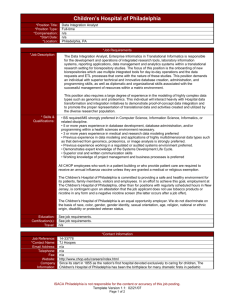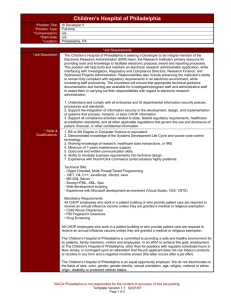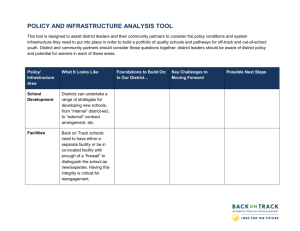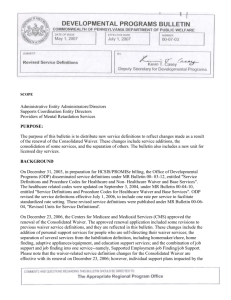Consumers could easily overlook the steady drip
advertisement
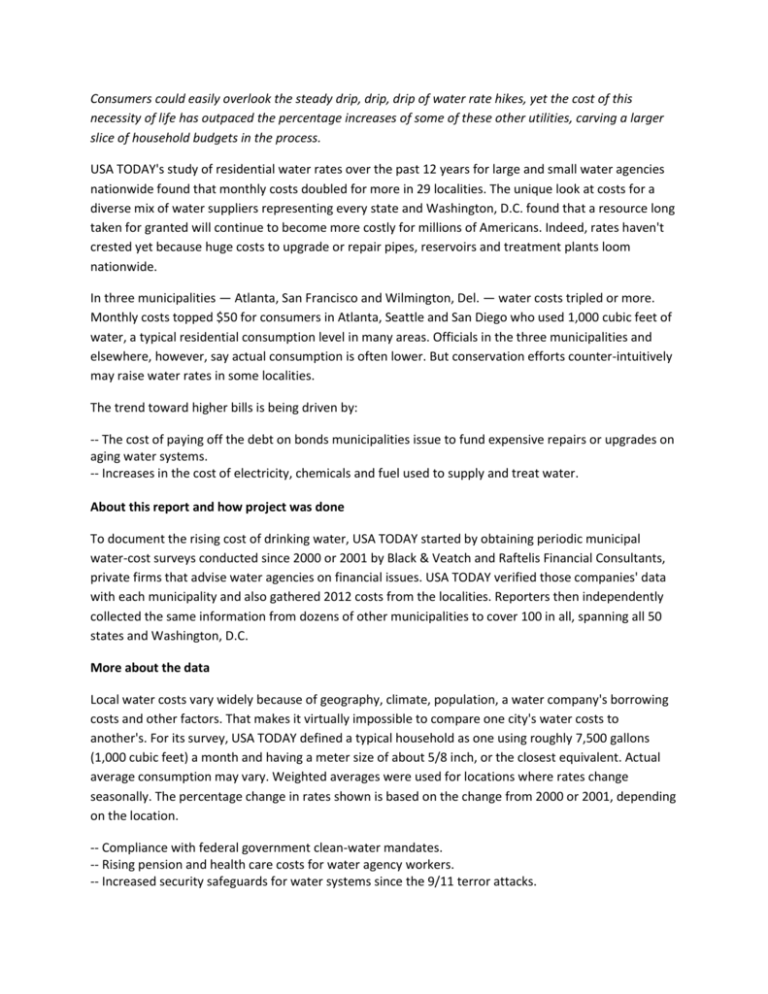
Consumers could easily overlook the steady drip, drip, drip of water rate hikes, yet the cost of this necessity of life has outpaced the percentage increases of some of these other utilities, carving a larger slice of household budgets in the process. USA TODAY's study of residential water rates over the past 12 years for large and small water agencies nationwide found that monthly costs doubled for more in 29 localities. The unique look at costs for a diverse mix of water suppliers representing every state and Washington, D.C. found that a resource long taken for granted will continue to become more costly for millions of Americans. Indeed, rates haven't crested yet because huge costs to upgrade or repair pipes, reservoirs and treatment plants loom nationwide. In three municipalities — Atlanta, San Francisco and Wilmington, Del. — water costs tripled or more. Monthly costs topped $50 for consumers in Atlanta, Seattle and San Diego who used 1,000 cubic feet of water, a typical residential consumption level in many areas. Officials in the three municipalities and elsewhere, however, say actual consumption is often lower. But conservation efforts counter-intuitively may raise water rates in some localities. The trend toward higher bills is being driven by: -- The cost of paying off the debt on bonds municipalities issue to fund expensive repairs or upgrades on aging water systems. -- Increases in the cost of electricity, chemicals and fuel used to supply and treat water. About this report and how project was done To document the rising cost of drinking water, USA TODAY started by obtaining periodic municipal water-cost surveys conducted since 2000 or 2001 by Black & Veatch and Raftelis Financial Consultants, private firms that advise water agencies on financial issues. USA TODAY verified those companies' data with each municipality and also gathered 2012 costs from the localities. Reporters then independently collected the same information from dozens of other municipalities to cover 100 in all, spanning all 50 states and Washington, D.C. More about the data Local water costs vary widely because of geography, climate, population, a water company's borrowing costs and other factors. That makes it virtually impossible to compare one city's water costs to another's. For its survey, USA TODAY defined a typical household as one using roughly 7,500 gallons (1,000 cubic feet) a month and having a meter size of about 5/8 inch, or the closest equivalent. Actual average consumption may vary. Weighted averages were used for locations where rates change seasonally. The percentage change in rates shown is based on the change from 2000 or 2001, depending on the location. -- Compliance with federal government clean-water mandates. -- Rising pension and health care costs for water agency workers. -- Increased security safeguards for water systems since the 9/11 terror attacks. Higher rates still ahead The costs continue to rise even though residential water usage dropped sharply nationwide in the past three decades amid conservation efforts. U.S. water systems will need as much as $1 trillion in infrastructure improvements by 2035 to keep up with drinking water needs, according to a survey of industry experts released in June. The bond debt needed to fund those projects' work will be passed on to consumers, including the many Americans struggling with the economic fallout of the great recession. A virtually irreplaceable resource that Americans rely on for health and daily living "could potentially get more and more expensive," says John Chevrette, who heads the management consulting arm of Black & Veatch, the firm that conducted the industry survey. He predicts rate increases of 5% to 15% every few years, saying the cost of water "could take a larger and more significant bite out of otherwise disposable income." "You're talking about greater than inflationary costs," says Doug Scott, managing director for Fitch Ratings, which similarly projects 5% annual rate increases among the many water and sewer agencies his company tracks. Some water agencies, including Philadelphia, have special water programs to help cut costs for those with low incomes. Even so, the economic forecasts frighten Moncrief, a single mother who bought her home in Philadelphia's Mount Airy neighborhood decades ago, and now lives there on a disability income. The monthly cost of 1,000 cubic feet of water in her hometown has jumped 164%, to $39.22, since 2001. Even when the costs were lower, Moncrief says at times she had to work out installment payments with the Philadelphia Water Department. Testifying at a July hearing in an ongoing water rate increase proceeding, Ruth Bazemore said she and other Philadelphia senior citizens were astounded that the city's water commissioner proposed hikes that would "increase our bills by almost 30% in less than three years." Community opposition prompted a tentative settlement that would save consumers at least $80 per year from the ultimate cost of the city's original proposal, says Robert Ballenger, a Community Legal Services attorney who represents the public in the Philadelphia rate hike proceeding. Bazemore, a representative of the Action Alliance of Senior Citizens of Greater Philadelphia, says even a lower increase "would be difficult for a lot of people to pay." Efforts to compare water costs of any given area with another produce misleading or even false results, because of differences in population, geography, geology, bonding debt for infrastructure work and other variables. However, what most water agencies across the nation share is increasing costs that make higher bills all but inevitable. In Baltimore, where water costs are up 140% since 2001, the public works agency in the last decade completed a $65 million upgrade of the water system's Ashburton Filtration Plant. After a series of major water main breaks in 2009, the city made plans to speed the pace of pipe cleaning, relining and rehabilitation work to 40 miles per year, a five-fold increase. The cost? About $300 million over five years, says agency spokesman Kurt Kocher. At the same time, Baltimore, like water systems nationwide, was forced to implement costly security upgrades at its facilities. "It's not the world of 1990. It's the post-9/11 security world we have to deal with," says Kocher. Bonds are not free money Municipal water systems typically fund major repairs and other infrastructure work by issuing bonds that are repaid over time. The annual cost of paying off debt servicing those bonds is passed on to consumers in higher rates. The financial impact is already being felt. Fitch Ratings showed water agencies' debt per customer rose from $1,012 in 2006 to $1,611 in 2011. Atlanta officials say their rates — up 233% since 2001 for monthly usage of 1,000 cubic feet of water — partly result from $1.3 billion in spending to upgrade the city's water supply system in compliance with federal clean water mandates. Conserving, yet costs still rise Unique geographic conditions and other circumstances can also raise costs. In Augusta, Maine, the monthly cost of 1,000 cubic feet of water has topped $40 since 2000. That's partly because the city has a small base of approximately 5,800 mostly residential customers and lacks major industrial customers that would help share the cost, says Brian Tarbuck, general manager of the Greater Augusta Utility District. "Coupled with our 10 storage tanks, deep frost conditions — pipes are literally 'six feet under' to avoid freezing — low (number of) customers per mile of pipe and lots of granite and hills, it gets expensive," says Tarbuck. U.S. homeowners who reduce their water consumption in an effort to save money can cut their costs. But they may end up raising the rates they're charged. Why? Because water suppliers collect less income as consumption drops, but ongoing costs -- such as bonding debt, salaries and chemicals -either increase or, at best, remain stable. A 2010 report by the Water Research Foundation, a non-profit organization that studies drinking water issues, concluded that residential usage per customer dropped more than 380 gallons annually in the last 30 years, a changing era when conservation became more prevalent. Compounded over time, the report says the trend implies that a customer would have used 11,673 fewer gallons in 2008 than an identical customer in 1978, a 13.2% decline. As a result, many water agencies have been forced to raise rates. "When we explain that part of the reason you're paying more is because you're using less, that doesn't go over real well with a lot of people," says Joseph Clare, the Philadelphia Water Department's deputy commissioner for finance and administration.

